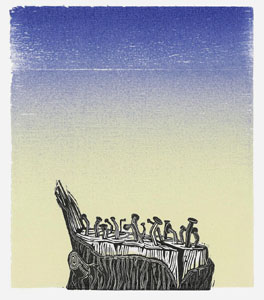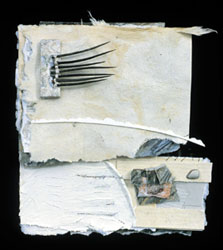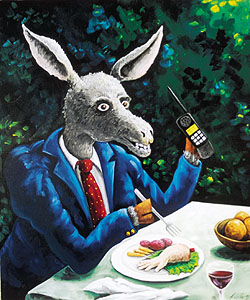








Exhibitions - Fall 2000
October 11 |
|
| August 28 - October 11 |
Fifth Biennial Alumni Exhibition |
| October 23 - December 15 |
Photographs at St. Lawrence University |
Greg Lago: Just Prints
Organized by Mark McMurray,
Curator of Special Collections, Owen D. Young Library
- August 21 - October 11, 2000
- Related Educational Programs

ed. 6/10, 6 7/8 x 6 inches
My older brother and I were born drawing. We began making images in earnest at around three or four years of age on paper towels. My mother encouraged the activity because it kept us busy at the kitchen table on laundry days at a time when whole days were given over to laundry.
As we grew older, we made three-dimensional objects using a jack knife swiped from my father, carving and whittling sticks until one of us would incur a flesh wound and bleed profusely. We made toy guns, wooden swords, knives, and spears-all the accoutrements required for mock war. Several hours of combat usually ended with me and my siblings sitting in various assigned corners, faces to the walls, throughout our old house. In this P.O.W. status, television on our ten-inch black-and-white screen was forbidden.
It was thus out of necessity that my brothers and I discovered books, particularly letterpress books that were cheap in 1955 as the technology of letterpress printing fell from commercial grace. With their incised, cuneiform codes inscribed in positive and negative space, and the timeworn smell and feel of their rag paper pages, these letterpress books seemed to us mysterious. But we found in them tangible proof of lives and ideas, foreign and familiar. Books spoke about all the unspoken things. They held answers in their pages. Once decoded, the ideas contained within books became common property; they became our ideas. I looked at the pictures mostly, while my brothers read to me. The power of illustrators like Rockwell Kent, who worked essentially in black and white, never left me.
The austere, straightforward, and elegant simplicity of wood engraved images always implied to me a way of seeing that is peculiar to the North Country. Lagos have lived in Jefferson and St. Lawrence Counties for at least 160 years. Besides farmers, they were carpenters, wheelwrights and millwrights, loggers, cutters of wood. Direct and inexpensive in its heyday, wood engraving seemed a natural progression from drawing an image to reproducing an image. Working with wood, either engraving or carving, just fit into my sense of time and place. My engravings have been described as oddly skewed visual parables—a blend of dark humor and illuminating truth—but always relying in a very traditional sense on people’s instincts to find common experience. -GL
Gregory Lago is a wood engraver whose work has been included in major books arts and print exhibitions in Los Angeles, San Francisco, Washington, D.C., and New York City. In 1988, he established Winged Bull Studio, a print gallery in Clayton, New York. His work can be seen at Susan Teller Gallery, NYC.

mixed media collage, 5 x 4 inches
Fifth Biennial Alumni Exhibition
Organized by Roger Bailey
- August 28 - October 11, 2000
- Related Educational Programs
Curator's Statement
If a visitor to this exhibition were to focus merely on techniques, he/she would see some interesting differences in the various skills and styles that include drawing, collage, painting, and photography. And that would miss the point of this exhibition. I hope viewers will take the time and make the effort to see the ways in which the works of these four alumni are connected. These artists are allied not simply by the fact that all four graduated from St. Lawrence, but from the fact that each artist works from a deeply felt personal force—something emotional and spiritual that compels them to create. Lori Schafer’s passionate drawings speak about a deep relationship with food. Lee van Laer’s oil paintings fulfill a spiritual need as they relate to the tradition of storytelling. Dana Henry’s collages and watercolors “seek to find the rhythm and beauty that alludes to a creature’s power of movement.” Mark Klett’s photographs shows us “the land as a mirror, not separate from ourselves, but a reflection of our own image.” This exhibition provides an opportunity for us to consider the relationships between art and life, and I thank the artists for their willingness to share their perceptions, thoughts, and feelings with us.
-Roger Bailey

watercolor and graphite on paper, 22 x 30 inches
Dana Henry
Volant means “capable of flight” or “moving with wings outstretched.” My collages study creatures commonly found in flight (birds, insects, etc.), undersea creatures “with wings oustretched,” and those animals for whom a first response to anything is flight. My perception involves seeing part of the whole and finding rhythm and beauty that alludes to the creature’s power of movement (flight). Instead of looking at the animal and asking what it is, my collages ask what does it feel like to float through water, to have barnacles grow on skin, to be hunted, to migrate? These collages have to do with what is glimpsed through murky waters and how we respond to that glimpse. My watercolors embrace the idea of flight, too, but examine the creatures that seem to have been in the wrong place at the wrong time in evolution, and thus have earned our human disdain. These are the creatures that crawl under leaf litter, scuttle across sand, or burrow in mud. Perhaps if they had been on a different evolutionary path, they would be soaring swiftly through the air. Perhaps, since we all share so much DNA (and who knows what else), they have dreams, and perhaps, as they bubble deeply in mud or curl under rocks, they dream of flight. -DH
Dana Henry earned her B.A. from SLU in 1980 and her M.F.A. from Bowling Green State University in 1983. Her work has been exhibited and awarded nationally in juried, invitational, and group shows.

1995, oil on canvas, 36 x 30 inches
Lee van Laer
I believe that all artistic endeavors are essentially ways of telling stories. As Ellen Dissanyake pointed out, the arts a society produces, and the stories it thereby shares, are a vital way of bonding us together and fulfilling strong biological and deep spiritual needs. It is not too much to say that a society without stories loses all its internal meaning. And without meaning, there is no purpose in life. Somewhere “out there” exists a transcendental thing we call beauty. I think it is the same thing as God. In one way or another, every piece of art represents an effort to connect with that mystery, to create a bridge between us and the cosmos. Painting has allowed me the privilege of doing so through a process of alchemy, transforming base substances into ideas and visions. It is an act of magic, of pulling metaphysical rabbits out of a hat. When I paint, I know I’m working hard when I’m literally shaking inside with fear and excitement—the acute, physical sensation of being right up against the unknown. At those moments, I recall what I felt at the birth of my children; it’s the same inner feeling. Life is an experiment in which we are called upon to experiment. All of my paintings are experiments—arrows shot off in the direction of meaning. Only time will tell if any of them were aimed truly. -LVL
Born in 1955 in Yonkers, NY, Lee van Laer spent most of his childhood in Hamburg, Germany. He earned his B.A. from SLU in 1977. He spent several years as a freelance artist before embarking on a career in wholesale and retail sales and is currently employed as the Vice-President of Imports at Fashion Industries in Griffin, GA, a manufacturer of home textile products. Although van Laer’s last professional exhibition was at Paolo Salvator Gallery in NYC in 1983, he has pursued fine art as an adjunct to his professional activities throughout his career. In addition to his oil paintings and drawings, van Laer plays loud rock guitar and writes trashy novels. He maintains a strong layman’s interest in science, religion, and philosophy, and is an avid rock hound whenever the opportunity presents itself.

charcoal, chalk, and pastel on paper, 42 x 28 inches
Lori Schafer
The natural world of organically grown produce continues to fascinate me as an artist. My progressive commitment to a vegetarian lifestyle has led me to this thematic place. Having an emotional relationship with my food has motivated me to observe the similarities between vegetable and human forms. I choose to have an unconventional perspective, thus the unique character of individual objects is revealed—humorous, sad, sexual, venerable, powerful. Drawing allows me the necessary liberty to work large, quickly, aggressively, passionately, with my hands and often with my knees, on papers of assorted fibers, textures, and colors that become an integral component in the mix.
I am a country girl at heart. I have seen the big city, done the cultural thing, spoken foreign languages, and sampled exotic cuisines of cities near and far, but I have returned to my roots—those familial, geographic, and edible. Born outside of NYC, raised in the Hudson Valley, educated in New York’s North Country (St. Lawrence, 1986) and midtown Manhattan, my youth was spent bouncing back and forth between green acres and gleaming skyscrapers. Playing with art, studying art, caring for other people’s art—this is how I spent the first thirty years of my life. I now concern myself with my art alone, because my art is my life. I live my life and make my art in the Berkshire Mountains of Massachusetts, with my writer-man and my Chow Chow-girls. It is a good thing. -LS

with his laptop, 8:56 p.m., 8/8/97, Flaming Gorge, Wyoming.,
1997, gelatin silver print, 16 x 20 inches
Mark C. Klett
I make photographs where land, history and culture collide, pursuing projects that involve time, address human interactions with the land, examine landscape representation, or attempt to generate new ways of looking at places. The Rephotographic Survey Project introduced me to landscape photography. Begun in 1977, the RSP repeated one hundred and twenty-two photographs originally made for the geological surveys of the American West in the 1860s and ‘70s. Updating the RSP in the late 1990s, the Third View Project extends the sequence another twenty years by adding a third photograph to the series, and expands the original, through photography, video and interviews, by providing cultural contexts and human stories behind historic landscapes. In the early 1980s, I began my own Western survey of a sort, born of personal journeys. In this work I like to counter the traditional view that land is something distant and other, and that pictures of it are like trophies to be owned. From the RSP project, I learned that a landscape photographer is never a simple witness to his or her time, but a participant as well. The third group of photographs is about artifacts found in the land. I had been photographing landscapes for over a decade, when suddenly beneath my feet I discovered the ground. I'm interested in objects that fail the transition from junk to artifact, the things which will become the fossils of our own layer in stratigraphic history. -MK
A 1974 graduate of St. Lawrence University, Klett received his M.F.A in 1977 in photography from the Visual Studies Workshop, Rochester, NY, and is currently an associate professor of art at Arizona State University. His exhibitions and publications record is extensive, with recent one-person exhibitions at the Huntington, the Cleveland Museum of Art, and the National Museum of American Art at the Smithsonian Institution, among others. In public and private collections around the world, his photographs have been published in An American Century of Photography: From Dry-Plate to Digital and Innovation/Imagination: 50 Years of Polaroid Photography.
Photographs at St. Lawrence University
- October 23-December 15, 2000
- Related Educational Programs

1965-66, gelatin silver print, 19 13/16 x 15 7/8 in.,
gift of Donald T. Johnson, SLU 82.26.5
The Richard F. Brush Art Gallery announces the publication of Photographs at St. Lawrence University and an accompanying exhibition of over 125 photographs that represent a range of expressive strategies. Since its inception thirty-five years ago, the photography collection has grown to include nearly 1,000 photographs: some 600 individual photographs and 28 portfolios, series, and artists’ books consisting of over 325 photographs. In the last decade, the gallery has focused on photography in particular in terms of educational outreach and collection development. Photographs, more than any other works in the collection, are used to enhance teaching and learning in the wide variety of departments and programs that characterize an undergraduate liberal arts environment. Photographs at St. Lawrence University is the first publication to document comprehensively in printed form any aspect of the permanent collection. Students, faculty, scholars, and the broader community will be able to survey the collection via a checklist, over 200 duotone and full-color reproductions, and several interpretive essays that envision some of the ways photographs enhance teaching and learning.

July 1941, printed 1985, dye transfer print, 10 x 13 in.,
gift of Rick Jeffrey (parent of Richard Jeffrey Jr. '85, SLU 92.11.25
Gary D. Sampson, photography historian and co-editor of the publication, writes about the significance of the photographs in St. Lawrence University’s collection and places them in historical and theoretical contexts. He and I invited two nationally recognized photographers, Bill Gaskins and Esther Parada, to contribute feature essays. Both artists address the politics of representation. Gaskins discusses race and photography in the academy, and Parada’s new photo/text essay presents a critical response to the work of North American photographers including Paul Strand and Manuel Alvarez Bravo in Mexico. Alumni Eloy J. Hernández '93, Michael E. Hoffman ‘64, Mark C. Klett ‘74, and Thomas W. Southall ‘73 offer perspectives as cultural critic, publisher, photographer/teacher, and museum curator, respectively. At St. Lawrence, the gallery’s assistant director, Carole Mathey, discusses integrating photographs from the collection into the curriculum. Art historian Dorothy Limouze writes about the challenges of teaching with photographic images and the need to reunite creative photography with art history, and Mark C. McMurray describes selected photographs from the Libraries’ Special Collections and University Archives.
-Catherine Tedford, gallery director and co-editor
In his book Camera Lucida, the French theorist Roland Barthes challenges readers with his paradoxical statement regarding the photograph as “a certain but fugitive testimony.” In other words, the subject appearing in a photograph may seem to be immediately present to the viewer, yet it is not really there, but only a trace of what originally came before the camera. Furthermore, the significance of a photograph is contingent on the ways it has been disseminated and received by various viewers and institutions from the moment of its release into a public domain. The assertion of realism; the veneration of the fine print for its subtlety of tonal gradation and resolution; the medium’s peculiar capacity to pluck a moment from the continuum of time; the subjective vision of the artist: these are key elements in the formation of modern photography and the related criteria by which photographs have been acquired by art museums and galleries.
The exhibition is organized into six thematic groupings in order to reveal the scope and character of the photography collection at St. Lawrence University. The themes are also intended to provoke discussion concerning the function of such collections in educational communities. Four of these are suggested by the collection itself as related to established narratives of photo history: the documentary ethos (photojournalism, social documentary, portraiture and the notion of the celebrity); the pictorialist impulse (art photography, symbolism, high art photography institutions and their impact, amateur societies); modernist idioms (formalism, the social dynamics of modernist imagery); and nature and transcendence (the “Equivalent” or “nature” as metaphor, landscape as spectacle and conduit of the spiritual). The fifth grouping is informed by contemporary social and cultural issues and explores points of contestation in the traditional narratives of photo history (works critical of modernism and traditional modes of documentation). Finally, transmutations of the medium addresses the changing nature of visual representation and the photographic image in the digital age. The groupings are not meant to be thematic ends in themselves, but rather to suggest connections and to raise questions regarding the photograph as a potent object of aesthetic, social, and political significance.
-Gary D. Sampson, curator and co-editor
All exhibitions and related educational programs are free
and open to the public. The Gallery welcomes individuals and groups for guided
tours; please call (315) 229-5174 for
information.
Gallery hours Monday-Thursday
Friday and Saturday12-8 p.m.
12-5 p.m.
top of page